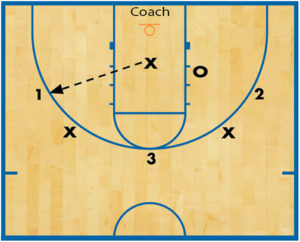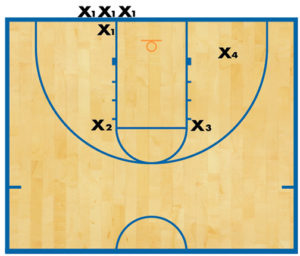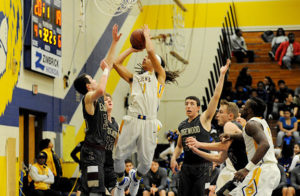’94 Drill’ pushes players to give full-court effort
Court availability is always an issue at some schools. With more teams wanting more practice time, sometimes it’s close to impossible to have a full court for two hours of practice.
When you do have a full court available for your team’s exclusive use, put it to work. Develop drills that get your players moving while utilizing every basket.
 The 94 Drill does just that while improving conditioning, ball handling in traffic and working on a variety of shots. The luxury of the drill is that you can have any number of players going through this drill at the same time. No more than 15 is recommended, and eight to 12 probably is best to avoid crowding. Coaches can run the drill for as long or as little as they like.
The 94 Drill does just that while improving conditioning, ball handling in traffic and working on a variety of shots. The luxury of the drill is that you can have any number of players going through this drill at the same time. No more than 15 is recommended, and eight to 12 probably is best to avoid crowding. Coaches can run the drill for as long or as little as they like.
We typically go for five minutes with the 94 Drill. While it may look like a complicated drill, the setup and execution is quite simple as long as your players understand and follow directions.
The 94 Drill
DIAGRAM 1: Each player gets a ball and lines up, beginning about 10 feet behind the 3-point line. The first player dribbles to an area between the 3-point line and the foul line (depending on that player’s shooting range). The player then jump-stops and shoots a jumper at basket one. The next player begins after the first player takes their first shot. The third player begins after the second player takes their first shot, and so on.
After the first player takes the first shot, they rebound the ball, dribble toward basket two, and shoot a wing jumper. They then rebound that shot and speed-dribble toward basket three. At basket three, they take a left-handed layup. The next step is to dribble to basket four and shoot a baseline jumper. The player then rebounds that shot and speed-dribbles toward basket five for a right-handed layup. The player then approaches basket six for another baseline jumper. The drill repeats until time expires.
» ALSO SEE: Warmup ball handling drill gets players moving
Here are five notes to guide coaches through common situations that arise during the drill.
1. The only time that players wait for the previous player to shoot is at the first basket. This creates initial spacing between players. To keep the drill moving, no other waiting should occur. By running this drill as a cohesive unit, it keeps players focused on their assignments while also paying attention to others around them. They can’t simply put their head down and methodically go through the motions to complete each shot. By speed-dribbling across the court with other action taking place around them, everyone must have their heads on a swivel.
2. Players should focus on dribbling with their heads up. This directly relates to the first point. To further stress this rule, have players wear dribble goggles so they don’t allow their heads to drift toward the floor.
3. Players may pass by slower players. Once again, this keeps players moving. The slower players aren’t going to want to be passed, and it provides motivation to the faster players who want to complete the drill in as little time. Yet it still encourages effort on each shot.
4. To increase difficulty, managers or coaches should contest jump shots or layups. This refers back to players going through the motions. If some of them are great shooters, short jumpers and layups may not be challenging. Jump out at them, put a hand in their face, and make them want to knock down all six shots without a miss.
5. Incorporate point values for shots, require team totals and run the difference. Establish either team or individual goals for the duration of the drill. To keep score, have managers counting points for every shot. Or, players could be broken into two groups with the resting players counting points for the opposite team. Coaches also could go with honesty and have individual players keep track of their own scores.












